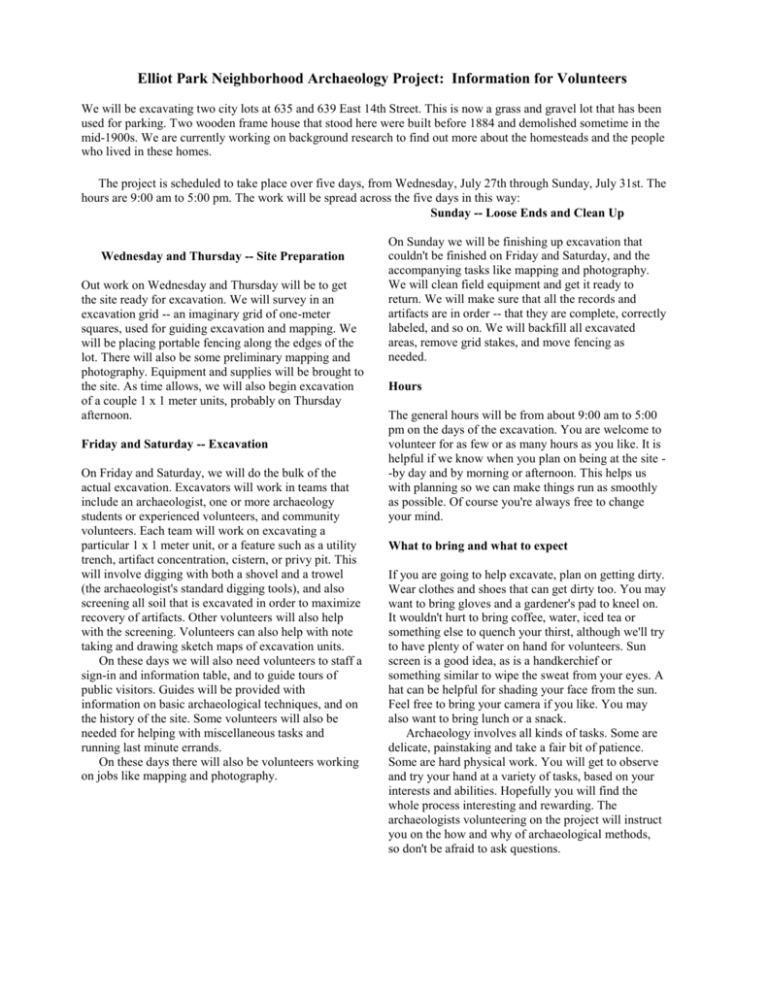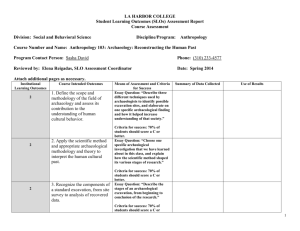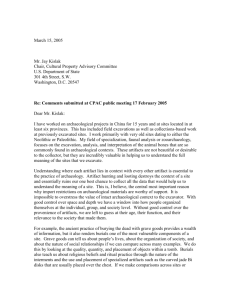some basics of archaeology
advertisement

Elliot Park Neighborhood Archaeology Project: Information for Volunteers We will be excavating two city lots at 635 and 639 East 14th Street. This is now a grass and gravel lot that has been used for parking. Two wooden frame house that stood here were built before 1884 and demolished sometime in the mid-1900s. We are currently working on background research to find out more about the homesteads and the people who lived in these homes. The project is scheduled to take place over five days, from Wednesday, July 27th through Sunday, July 31st. The hours are 9:00 am to 5:00 pm. The work will be spread across the five days in this way: Sunday -- Loose Ends and Clean Up Wednesday and Thursday -- Site Preparation Out work on Wednesday and Thursday will be to get the site ready for excavation. We will survey in an excavation grid -- an imaginary grid of one-meter squares, used for guiding excavation and mapping. We will be placing portable fencing along the edges of the lot. There will also be some preliminary mapping and photography. Equipment and supplies will be brought to the site. As time allows, we will also begin excavation of a couple 1 x 1 meter units, probably on Thursday afternoon. Friday and Saturday -- Excavation On Friday and Saturday, we will do the bulk of the actual excavation. Excavators will work in teams that include an archaeologist, one or more archaeology students or experienced volunteers, and community volunteers. Each team will work on excavating a particular 1 x 1 meter unit, or a feature such as a utility trench, artifact concentration, cistern, or privy pit. This will involve digging with both a shovel and a trowel (the archaeologist's standard digging tools), and also screening all soil that is excavated in order to maximize recovery of artifacts. Other volunteers will also help with the screening. Volunteers can also help with note taking and drawing sketch maps of excavation units. On these days we will also need volunteers to staff a sign-in and information table, and to guide tours of public visitors. Guides will be provided with information on basic archaeological techniques, and on the history of the site. Some volunteers will also be needed for helping with miscellaneous tasks and running last minute errands. On these days there will also be volunteers working on jobs like mapping and photography. On Sunday we will be finishing up excavation that couldn't be finished on Friday and Saturday, and the accompanying tasks like mapping and photography. We will clean field equipment and get it ready to return. We will make sure that all the records and artifacts are in order -- that they are complete, correctly labeled, and so on. We will backfill all excavated areas, remove grid stakes, and move fencing as needed. Hours The general hours will be from about 9:00 am to 5:00 pm on the days of the excavation. You are welcome to volunteer for as few or as many hours as you like. It is helpful if we know when you plan on being at the site -by day and by morning or afternoon. This helps us with planning so we can make things run as smoothly as possible. Of course you're always free to change your mind. What to bring and what to expect If you are going to help excavate, plan on getting dirty. Wear clothes and shoes that can get dirty too. You may want to bring gloves and a gardener's pad to kneel on. It wouldn't hurt to bring coffee, water, iced tea or something else to quench your thirst, although we'll try to have plenty of water on hand for volunteers. Sun screen is a good idea, as is a handkerchief or something similar to wipe the sweat from your eyes. A hat can be helpful for shading your face from the sun. Feel free to bring your camera if you like. You may also want to bring lunch or a snack. Archaeology involves all kinds of tasks. Some are delicate, painstaking and take a fair bit of patience. Some are hard physical work. You will get to observe and try your hand at a variety of tasks, based on your interests and abilities. Hopefully you will find the whole process interesting and rewarding. The archaeologists volunteering on the project will instruct you on the how and why of archaeological methods, so don't be afraid to ask questions. Cautions and Precautions Precautions on an archaeological excavation are pretty much common sense. Don't step in somebody's carefully excavated unit. Watch out for holes or uneven ground. There are sharp things in the dirt (including the dirt in the screen), so keep your eyes open. Watch where you're throwing dirt. Make sure that artifacts don't get mixed up and separated from their proper bags or buckets. Observe carefully as you work. Take care of the tools and equipment. Remember that we're all volunteers on this project, so be patient The weather may be quite warm. Make sure that you get out of the sun whenever you need to, and make very sure that you drink enough water. The volunteer staff will be pestering you about both of these things. Safety first -- be careful! Know your limits. Don't try to lift too much and don't push yourself too hard. This is supposed to be fun, after all. Watch out for holes or uneven ground; be aware that fences are there for a reason. Historic artifacts include broken glass and bits of sharp metal, so be careful for sharp things and pay attention. The volunteer staff will also be reminding you about this repeatedly. Please don't walk on any excavation areas or any areas that are fenced or taped off. Archaeological remains can be fragile, and a misplaced step can cause damage. In the event of rain, please look around and make sure that records, artifact bags, tools and other materials are either protected or moved to shelter. In the event of dangerous weather, worry first about getting yourself and other people to safety -- we have arranged to have access to storm shelter if needed. None of the materials or equipment are as important as the safety of the people at the site. Remember not to remove any objects from the ground unless you are doing it as part of a systematic excavation. The placement of an artifact is part of its context; moving pieces alters this context, and destroys information. Be careful about making sure that artifacts are kept in their labeled buckets or bags. It's easy to get things mixed up, which compromises the information that we retrieve from this site. Please do not take any artifacts from the site. Although it may seem that the bits of broken glass or other materials are abundant, they together form an integrated record of what happened here. Loss of even a few bits can compromise that record. Think of it this way: the materials that we sample from the site belong to the whole community -- our neighborhood and beyond. We are just caretakers. And please -- no food or smoking in the excavation area. Food crumbs and tobacco ashes can contaminate samples.






